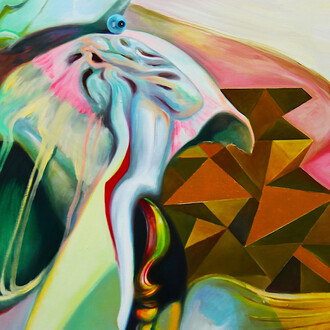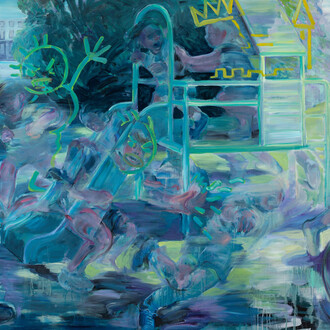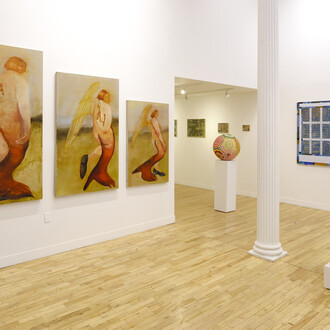Solo pienso en volver a verte is a kaleidoscopic rumination on the love and care that a simple gesture can carry. Maria Guzmán Capron’s newest body of work, showcased in this exhibition, grew out of one such tender moment when she created a token of affection for a dear friend in the form of a textile flower. Flowers, we could argue, are among the most popular sentimental gifts. A favorite of children, who full of innocence and sweetness, pick handfuls of wildflowers to bring to a loved one, and adults alike, who buy them at the grocery store or floral shops as a show of romance or to commemorate a celebration. The artist selected the title, translating to “I only think about seeing you again,” from the stock greeting cards that usually accompany flower arrangements. It is an endearing and fitting pairing to the bouquet of quilted works, exuding passion and longing she offers in this presentation. And while many might think of flowers as cliché, Guzmán Capron’s approach is a genuine and heartfelt memorialization of the desire to express love.
The gallery transforms into a secret garden of Guzmán Capron’s making. Flowers bloom along the wall, cocooning figures within their protective petals like characters out of a fairy tale, framing compositions and efflorescing on the surface of textiles. After experimenting with the format of curtains in recent exhibitions at El Museo del Barrio and the University of Buffalo Art Galleries, Guzmán Capron has depicted a series of windows for this presentation that ground her figures in a domestic space or home. Florals soften the rectilinear structure, inviting visitors into these intimate spaces to reflect on love and our bids for connection. This exhibition is an idiosyncratic entry into the history of the language of flowers (or floriography), a thousands-year-old intricate coded system popularized in the Victorian era, used to share secret messages, especially of love and friendship, through the type, color, and combinations of flowers. For Guzmán Capron, flowers are symbolic vessels that hold unspoken desires and hidden selves.
Guzmán Capron’s figures not only lovingly embrace but also become extensions of each other through their hybridized bodies made of a patchwork of textiles with a bewildering psychedelic quality. For the first time, Guzmán Capron, best known for her larger-than-life, playful, quilted figures in a riot of found, colorful, and patterned fabrics, has used only materials she developed through hand-dying and painting. This series continues the artist’s use of multiplicity in figures with more than one face, almost as if grafted, to convey the many versions of self within a body. She pushes this notion further by including small figurative illustrations tattooed on their skins to represent lingering memories, histories, and past selves. What was once a pursuit of finding the self and a preoccupation with endless reconfiguration within the mass-produced, Guzman Capron’s practice is now rooted in the desire to expand on love, whether it be of self or others, beyond what she can find on a shelf. Guzmán Capron’s work is more cohesive and personal than ever through a fresh approach towards materiality and composition, giving her vulnerable narratives a space to flourish.
(Text by Angelik Vizcarrondo-Laboy)
















